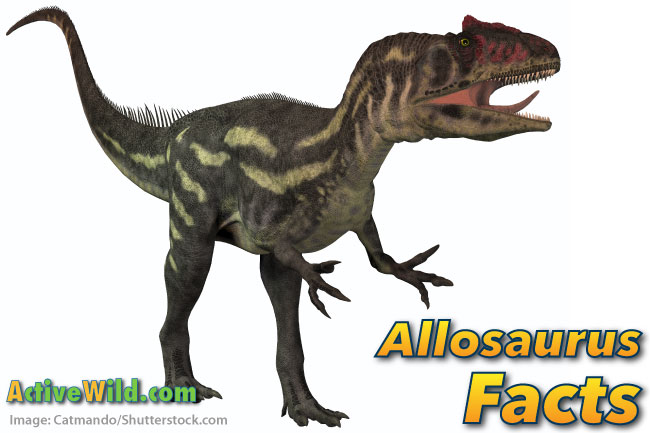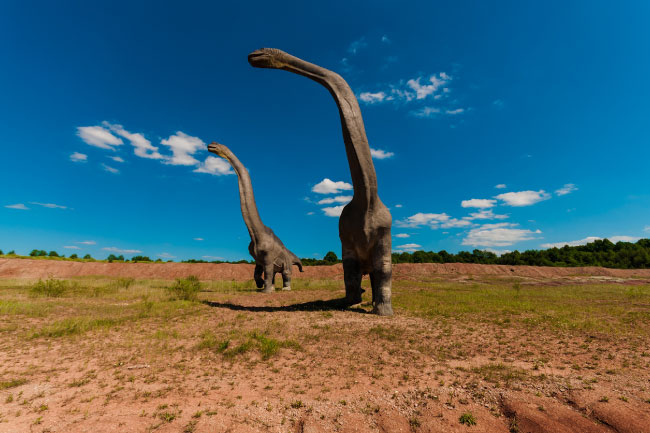This page contains Allosaurus facts for kids (and adults). Here you can learn all about one of the biggest, fiercest Jurassic predators …
- This article is part of our Dinosaur series. You can check out our main dinosaur page here: Dinosaur Facts
Allosaurus Facts for Kids: Introduction
Allosaurus was a large, carnivorous (meat eating) dinosaur. It lived in the late Jurassic / early Cretaceous period, around 155 – 140 million years ago.
In those days, the climate was warm and humid. The land would have been covered with forests, and there would have been no grass or flowers. Open areas would have been covered with ferns and palms.
Most Allosaurus fossils have been found in the USA. Allosaurus would have lived alongside other Jurassic dinosaurs such as Diplodocus and Stegosaurus.
The name Allosaurus means ‘different lizard’ in Greek. It was given this name because it had a different type of backbone to other dinosaurs that had been discovered at the time.
While it was alive, the Allosaurus was one of the largest meat-eating dinosaurs. The formidable – and much heavier – Tyrannosaurus wouldn’t make an appearance until 50 million years later.
Theropod
Allosaurus was a theropod. Early theropods were all carnivores like Allosaurus, but they would later evolve into insectivores (insect-eaters), herbivores (plant-eaters), and animals with various other dietary preferences.
Over millions of years – from the late Jurassic to the present day – theropods slowly evolved into birds. If you look out of a window ad see a bird, remember what its ancestors looked like!
What Did Allosaurus Look Like?
Allosaurus was a large bipedal dinosaur. Bipedal means that it stood and walked on two legs. Its hind legs were long and powerful. Its arms, although strong, were much shorter.
At the end of each arm were three curved and pointed claws, which were up to 15 cm (6 in) long.
Allosaurus' feet had three clawed toes, and a further smaller claw further up the foot.
Although Allosaurus was quite a bulky dinosaur, scientists think that it was a fast runner. One Allosaurus fossil has bones that had at one time been broken and had subsequently healed. Scientists think that the bones may have been broken in a high-speed pursuit.
Allosaurus jaws contained around 70 teeth. These pointed backwards, and were serrated to cut through flesh. These teeth were often lost, and would grow back.
Allosaurus jaws weren’t particularly strong. It is thought that rather than crushing bones, the jaws and teeth were used for ripping and slicing off flesh.
Allosaurus Facts for Kids: How Big Was Allosaurus?
The biggest Allosaurus specimens are up to 12 metres (39 ft.) long. The average Allosaurus was around 8.5 m (28 ft.) long.
Allosaurus stood around 4.5 to 5 m (15 – 16.5 ft.) tall.
Allosaurus probably weighed between 1.4 (metric) tonnes (3,000 lb) and 2 (metric) tonnes (4,400 lb). Other estimates are even larger; some scientists think that Allosaurus may have weighed up to 4 tonnes.
Where Did Allosaurus Live?
Nearly all Allosaurus fossils have been found in the USA, with most being found in Colorado, Wyoming and Utah. Fossils that may have come from Allosaurus have also been found in Europe (Portugal), North Asia (Siberia) and Africa (Tanzania).
Of course, the world looked very different in the Jurassic era. There were no polar ice caps, and the continents were just starting to form into their present-day shapes. The North American continent had only just split from Eurasia.
What Did Allosaurus Eat?
Allosaurus was carnivorous, and probably preyed on a number of other Jurassic dinosaurs. Large sauropods, such as the Barosaurus, may have been on the menu.
Allosaurus may have hunted in packs to bring down the huge, long-necked dinosaurs. Large numbers of Allosaurus fossils found in one place may be evidence of this.
It is highly likely that Allosaurus preyed on Stegosaurus. An Allosaurus fossil has been found with a wound probably caused by a Stegosaurus tail spike. A Stegosaurus fossil has been found with wounds probably caused by Allosaurus jaws.
Allosaurus Fossils
The first fossil that was (later) identified as Allosaurus was found in Colorado in the mid-19th Century.
Allosaurus was named in 1877 by American paleontologist Othniel Charles Marsh.
Many Allosaurus fossils have been found in the Morrison Formation. This is a large band of sedimentary rock from the Jurassic period. Most of the Morrison Formation occurs in Wyoming and Colorado.
The Cleveland-Lloyd Quarry in Utah is also part of the Morrison Formation. Here, over 12,000 dinosaur bones have been found. Around 67% of these fossils are Allosaurus; scientists think that they come from around 44 individuals. This may suggest that Allosaurus hunted in packs.
Big Al
Perhaps the most famous Allosaurus is ‘Big Al’. Big Al is the name given to a 97% complete Allosaurus specimen found in 1991 in the Howe Dinosaur Quarry, in Shell, Wyoming.
‘Big Al Two’ – an even better preserved specimen – was discovered in the same quarry in 1996.
Evidence of infections and broken bones suffered by the original Big Al have been incredibly important in piecing together Allosaurus behaviour.
Top 10 Allosaurus Facts for Kids
- Allosaurus lived in the late Jurassic period, around 155 – 140 million years ago.
- Allosaurus was found in what is now the USA.
- Allosaurus walked on two legs.
- Allosaurus was carnivorous.
- The average Allosaurus was around 8.5 m (28 ft.) long.
- Allosaurus was around 4.5 to 5 m (15 – 16.5 ft.) tall.
- Allosaurus weighed around 2 tonnes (about the same as a car).
- Allosaurus had around 70 pointed teeth which were curved inwards.
- Allosaurus relied more on ripping and cutting to subdue its prey, rather than sheer, bone-breaking power.
- The most famous Allosaurus is ‘Big Al’, a near complete specimen found in Wyoming, USA
Now that you're an Allosaurus expert, why not take a look at our other dinosaur articles? Start here for a crash course in all things dinosaur: Dinosaur Facts.






